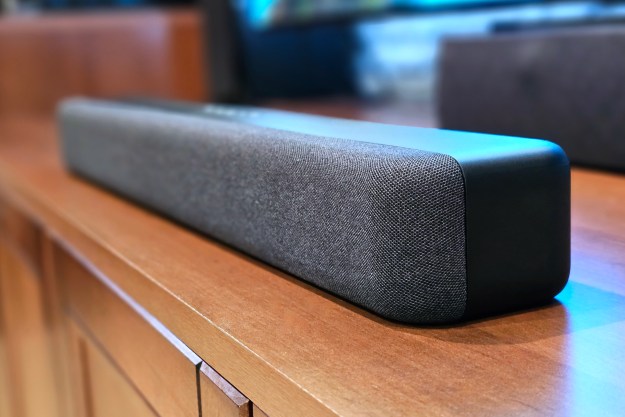
“It doesn't get much simpler than the Amazon Fire TV Soundbar.”
- Decent bass for a single speaker
- HDMI connection
- Effective virtual surround sound
- Weak midrange performance
- Some missing instructions
I’ll be honest: When Amazon announced its new Fire TV Soundbar during its fall 2023 hardware event, I had to suppress a yawn. After all, on paper, this speaker doesn’t exactly wow. It’s a simple two-driver, two-channel soundbar that connects to any TV via HDMI or optical, and it comes with its own remote, all for $120. So my expectations were pretty low.
And yet, after spending a week with the Fire TV Soundbar, watching movies and TV shows, and even streaming some music, I’m happy to say it’s not a bad little speaker. It’s no replacement for more expensive soundbars. But for those on a budget, here’s why I think it’s a good buy.
Is this a Fire TV streaming device?

Despite its name, the Fire TV Soundbar isn’t an actual Fire TV device. Connecting it to your TV won’t give you a Fire TV interface or give you access to any streaming media services. In other words, it’s a soundbar. Period.
While it’s true that if you own a Fire TV device — like the Fire TV Omni — you’ll be able to control the Fire TV Soundbar’s volume and power from your TV’s remote control, but this isn’t limited to Fire TVs. Any TV connected to the soundbar via HDMI will have a similar ability. What makes it unusual is that at this price ($100 to $120) you generally won’t get an HDMI port on a soundbar at all.
So why is it called a Fire TV Soundbar? According to Amazon, it’s because the company’s Fire TV team designed and produced it. OK, then.
Amazon Fire TV soundbar: what’s in the box?
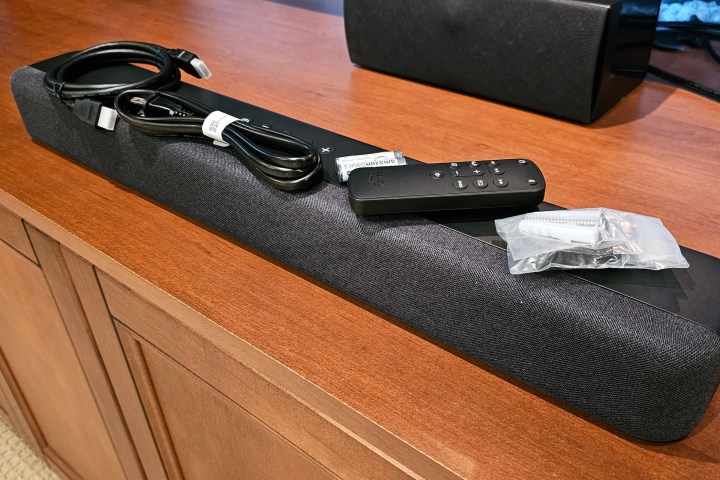
The Fire TV Soundbar comes with everything you need to get it connected and playing. You get a power cable, an HDMI cable, a remote control with batteries, a simple wall-mount kit, a quick start guide, and a wall-mounting template.
The only thing you may need to buy is an optical cable, but that’s only if your TV doesn’t have an HDMI ARC/eARC port, or if you want to connect an additional audio source (more on that in a moment).
Amazon Fire TV soundbar: design
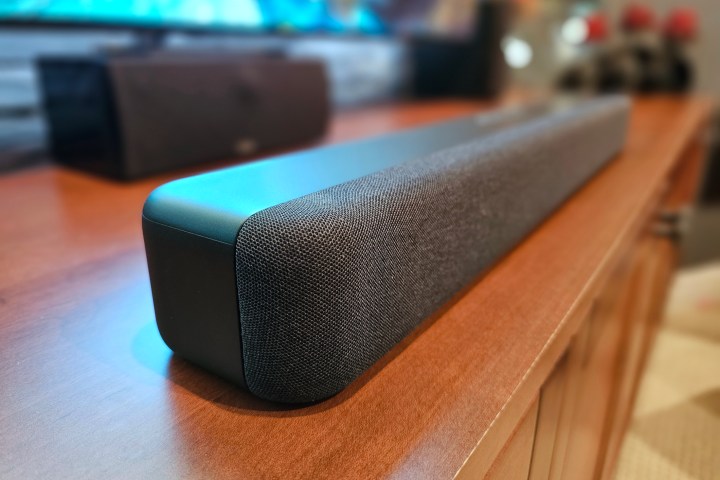
Like a lot of Amazon’s devices, the Fire TV soundbar is free of any visible logos. It’s a minimalist black rectangle with a matching fabric grille that wraps around the front four corners. You might be tempted to say it looks boring, but I’m a big believer that soundbars shouldn’t draw attention to themselves. And in that sense, the Fire TV Soundbar is perfect.

Size-wise, it’s going to fit almost anywhere. At 24 inches wide and 2.5 inches tall, it won’t look out of place in front of a 32-inch TV, and it’s narrow enough that you might even be able to place it between the legs of a larger TV.
There are five buttons on the top surface for basic functions like volume, source, power, and Bluetooth, but don’t lose the remote — it has additional functions that the soundbar’s buttons can’t replicate.
Amazon Fire TV soundbar: setup and connections
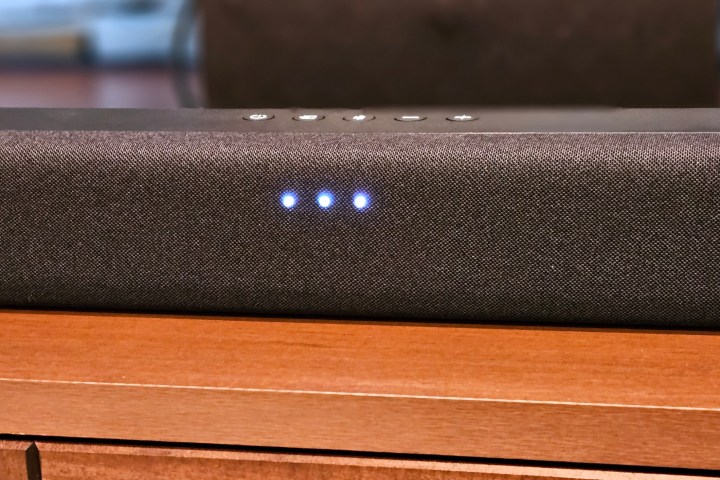
As with most basic soundbars, the Fire TV Soundbar is quite literally plug-and-play. Once you connect it to power and to your TV’s HDMI ARC/eARC port, and then turn on your TV, the soundbar should be automatically recognized and used as your TV’s sound output. If it isn’t, dive into your TV’s settings and make sure the sound is set to optical/HDMI (or HDMI if you don’t have an optical port).
Here’s a quick tip: If your TV has both HDMI ARC and optical (and you don’t mind using two remotes), use the optical connection. There’s no difference in sound quality, and you’ll be able to keep your HDMI ARC port available for other devices. Optical connections can handle any audio up to Dolby Digital 5.1, which the Fire TV Soundbar supports. Only Dolby Atmos soundbars require an HDMI connection to deliver sound at the highest possible quality.
For TV sound, you’re all done. Congrats. Your next option, should you choose to use it, is to connect an additional device like a CD player to the optical port if you kept it available and/or a USB drive to the USB port.
Because each of these is considered a discrete input, you can keep all three connected and jump between them using the input select button on the speaker or the remote. If you then decide to pair your phone, tablet, or other device via Bluetooth, the input selection will include that Bluetooth connection, so there’s no need to use the Bluetooth button once pairing is complete.

A nice touch is the use of a very familiar-sounding voice to announce each of these inputs as you cycle through them, instead of needing to decipher the three color-coded LEDs that appear behind the fabric grille.
Don’t want your speaker talking to you? A long press on the remote’s mute button will banish those announcements (repeat the long press to bring them back). Speaking of the remote, it’s not going to win any design awards. But it’s compact, with easy-to-press buttons that are covered in a layer of rubber. That should make it relatively spill-resistant when the inevitable TV dinner catastrophe occurs.
As easy as the Fire TV Soundbar is to set up and use, the lack of a full set of instructions, either in the box or online, is annoying. I have yet to find directions on how to use the USB port for playback of digital music files, but here’s what I have found — in case you need them:
- Change the audio settings on the Amazon Fire TV Soundbar
- What do the LEDs mean on the Amazon Fire TV Soundbar?
- Pair Bluetooth devices to the Amazon Fire TV Soundbar
One small caveat for Fire TV Omni owners: shortly after this review was published, a reader emailed us to say that pressing the mute button on either the Soundbar’s or the Omni’s remote was the equivalent of pressing the mute button twice — the Soundbar apparently receives the command via infrared from the remote itself, then again from the TV relayed through HDMI. The reader’s suggested workaround is use Amazon Alexa to mute the sound.
Amazon Fire TV soundbar: sound quality
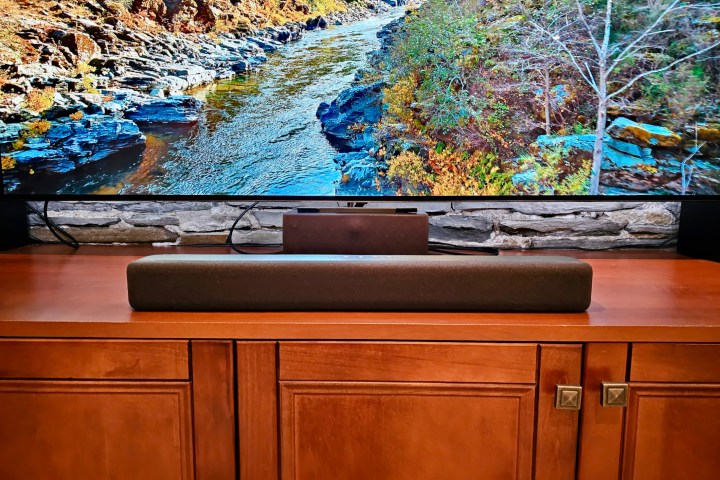
We buy soundbars because we don’t believe our TV’s built-in speaker system sounds very good, and we want something better. The two ways that TV speakers generally fail us is a lack of bass (good bass is one of the keys to a more theatrical sound experience) and a lack of dialogue intelligibility (“what did she just say?”).
The Fire TV Soundbar can solve both problems. Its low-end bass is surprisingly deep and resonant for a single speaker with no subwoofer, and when you shift the EQ mode to its dialogue setting, it does a decent job of emphasizing the higher frequencies associated with speech. With 40 watts of power, it gets more than loud enough for small rooms and can even handle some larger spaces too.
The real surprise, however, is the soundbar’s DTS Virtual:X surround sound mode. Engaging it instantly widens the soundstage, and you quickly forget that the little rectangular box under your TV is producing the sound — the audio feels like it’s coming from speakers on either side of your room. It works with any content – -and can be a fun way to listen to music too — but the effect is most pronounced when your source material is multichannel (e.g., Dolby Digital 5.1).
I enjoyed watching a number of big Hollywood films like Dune, Edge of Tomorrow, and Spider-Man: No Way Home using the Fire TV Soundbar. Even in standard Movie mode, I thought dialogue was clear, though I admit it was better on some movies than others.
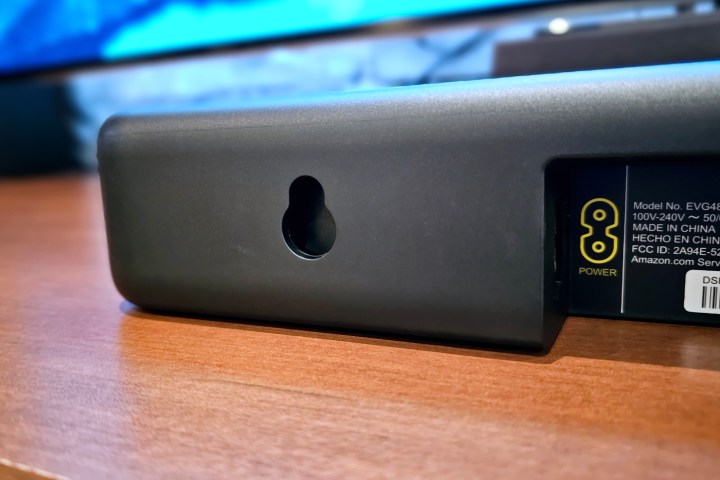
No, it’s not as good as a true Dolby Atmos soundbar playing Dolby Atmos content. And, yes, it could do with an external subwoofer for more bass impact. But it’s still a much more immersive experience than you’ll get from your TV alone.
If you’re picky about sound or you have golden ears, it’s pretty obvious that the Fire TV Soundbar has trouble with midrange frequencies. There’s a distinct lack of detail there. Using the Music EQ setting helps a little, as does dialing down the bass (there are three levels of bass boost), but it’s still noticeable.
Once you get sucked into the on-screen action of a big blockbuster movie, your brain will likely adapt pretty quickly — pumping the bass and using the surround mode is definitely the way to go — but streaming music via Bluetooth can be a little lackluster.
Again, it depends on your frame of reference. If you’re coming from a dedicated set of hi-fi stereo speakers, the Fire TV Soundbar can’t compare. But given that it’s essentially a giant Bluetooth speaker, it compares really well to smaller portable Bluetooth speakers in the same price range.
As a budget soundbar, the Amazon Fire TV Soundbar gets the job done. It’s easy to set up, easy to use, and it delivers better sound than many TVs — in some cases, considerably better sound.
Its biggest problem is that — unless you consider its HDMI port to be a benefit — it doesn’t really do any of this any better than the competition. For the same price or less, you can buy a Vizio, LG, or Samsung soundbar that will sound just as good, and possibly better.
Editors' Recommendations
- Best Amazon TV deals: Cheap TVs under $100
- The 5 best soundbars for Samsung TVs in 2024
- Best streaming devices for 2024: Apple TV, Roku, Fire TV, and more
- Sling TV adds arcade games on Fire TV and Android TV
- LG’s OLED Evo-tailored soundbar is available for preorder for $800




